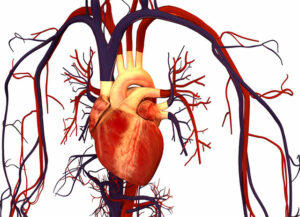GI AND CARDIOVASCULAR DISEASE

Today, I did something that I have never done in my whole life. I used artificial intelligence in the form of ChatGPT to help me write an article on the relationship between the GI and cardiovascular disease, this month’s theme for GI News. I registered first in ChatGPT. These were my instructions:
In approximately 1000 words, provide scientific evidence that the glycemic index of carbohydrate foods is relevant to the prevention and or management of cardiovascular disease (including coronary infarct and stroke, and risk factors such as hypertension, blood lipids, high density lipoprotein cholesterol (HDL) and triglycerides)
I was pleasantly surprised to find that it was reliable and made sense (at least to me), citing specific studies, mostly meta-analyses, currently the gold standard of scientific evidence. The only disappointing aspect was the lack of references and the rather robotic, repetitive language. Ahhh – there is still a need for us humans!
We have added a few key reference after the ChatGPT text for those who wish to read more. However, we are not 100% sure that these are the actual studies that ChatGPT was referring to in all cases!
Introduction
Cardiovascular disease (CVD) is a leading cause of morbidity and mortality globally. Diet is a modifiable risk factor for CVD, and the glycemic index (GI) of carbohydrate foods has been suggested as a potential tool for preventing and managing CVD. In this essay, we will explore the scientific evidence that supports the relevance of the GI of carbohydrate foods to the prevention and management of CVD, including coronary infarct, stroke, hypertension, blood lipids, high-density lipoprotein cholesterol (HDL), and triglycerides.
What is the glycemic index?
The GI is a measure of how quickly carbohydrates in foods are digested and absorbed, and how they affect blood glucose levels. Foods with a high GI are rapidly digested and absorbed, leading to a rapid increase in blood glucose levels, whereas foods with a low GI are slowly digested and absorbed, leading to a slower and more gradual increase in blood glucose levels. The GI of a food is influenced by several factors, including the type of carbohydrate, the amount of fiber, the degree of processing, and the presence of other nutrients, such as fat and protein.
The GI and CVD risk factors
Hypertension
Hypertension is a major risk factor for CVD. Several studies have suggested that the GI of carbohydrate foods may play a role in the development and management of hypertension. A systematic review and meta-analysis of 14 randomized controlled trials found that a low-GI diet was associated with a significant reduction in both systolic and diastolic blood pressure in hypertensive individuals. The authors suggested that the beneficial effect of a low-GI diet on blood pressure may be due to its ability to improve insulin sensitivity and reduce inflammation.
Blood lipids
Dyslipidemia, characterized by high levels of total cholesterol, low-density lipoprotein (LDL) cholesterol, and triglycerides, and low levels of HDL cholesterol, is a major risk factor for CVD. Several studies have investigated the relationship between the GI of carbohydrate foods and blood lipids.
A systematic review and meta-analysis of 37 randomized controlled trials found that a low-GI diet was associated with a significant reduction in total cholesterol, LDL cholesterol, and triglycerides, and a significant increase in HDL cholesterol, compared to a high-GI diet. The authors suggested that the beneficial effect of a low-GI diet on blood lipids may be due to its ability to reduce insulin resistance, increase satiety, and improve glycemic control.
Coronary infarct
Coronary infarct, also known as heart attack, is a major manifestation of CVD. Several studies have investigated the relationship between the GI of carbohydrate foods and the risk of coronary infarct.
A prospective cohort study of 65,126 women followed up for 10 years found that a high-GI diet was associated with a significantly increased risk of coronary infarct, after adjusting for several confounding factors, including age, smoking, physical activity, and body mass index. The authors suggested that the increased risk of coronary infarct associated with a high-GI diet may be due to its ability to increase insulin resistance, oxidative stress, and inflammation.
Stroke
Stroke is another major manifestation of CVD. Several studies have investigated the relationship between the GI of carbohydrate foods and the risk of stroke.
A meta-analysis of 8 prospective cohort studies found that a high-GI diet was associated with a significantly increased risk of stroke, after adjusting for several confounding factors, including age, sex, smoking, and alcohol consumption. The authors suggested that the increased risk of stroke associated with a high-GI diet may be due to its ability to increase insulin resistance, oxidative stress, and inflammation.
Read more:
- Evans and colleagues. Glycemic index, glycemic load, and blood pressure: a systematic review and meta-analysis of randomized controlled trials. Am J Clin Nutr. 2017
- Goff and colleagues. Low glycaemic index diets and blood lipids: a systematic review and meta-analysis of randomised controlled trials. Nutr Metab Cardiovasc Dis. 2013
- Livesey and colleagues. Coronary Heart Disease and Dietary Carbohydrate, Glycemic Index, and Glycemic Load: Dose-Response Meta-analyses of Prospective Cohort Studies. Mayo Clin Proc Innov Qual Outcomes. 2019
- Cai and colleagues. Carbohydrate Intake, Glycemic Index, Glycemic Load, and Stroke: A Meta-analysis of Prospective Cohort Studies. Asia Pac J Public Health. 2015
Emeritus professor Jennie Brand-Miller held a Personal Chair in Human Nutrition in the Charles Perkins Centre and the School of Life and Environmental Sciences, at the University of Sydney until she retired in December 2022. She is recognised around the world for her work on carbohydrates and the glycemic index (or GI) of foods, with over 300 scientific publications. Her books about the glycemic index have been bestsellers and made the GI a household word.








